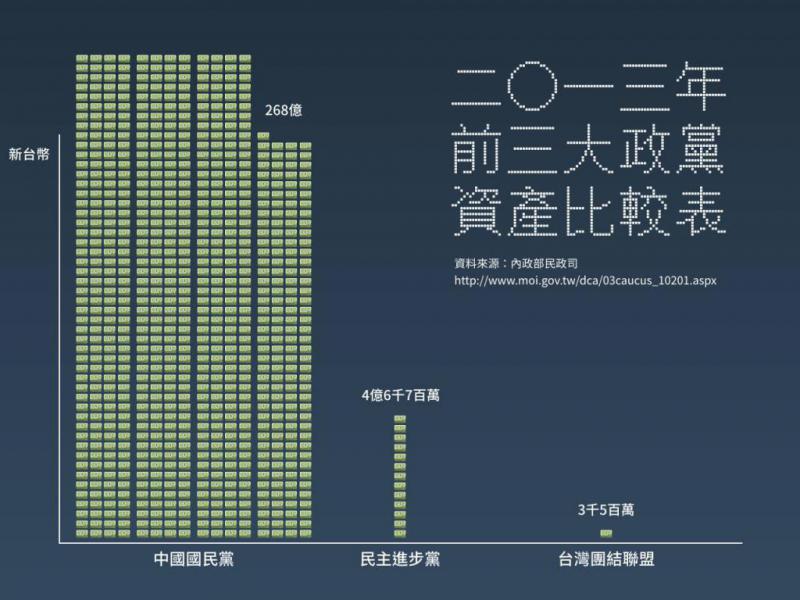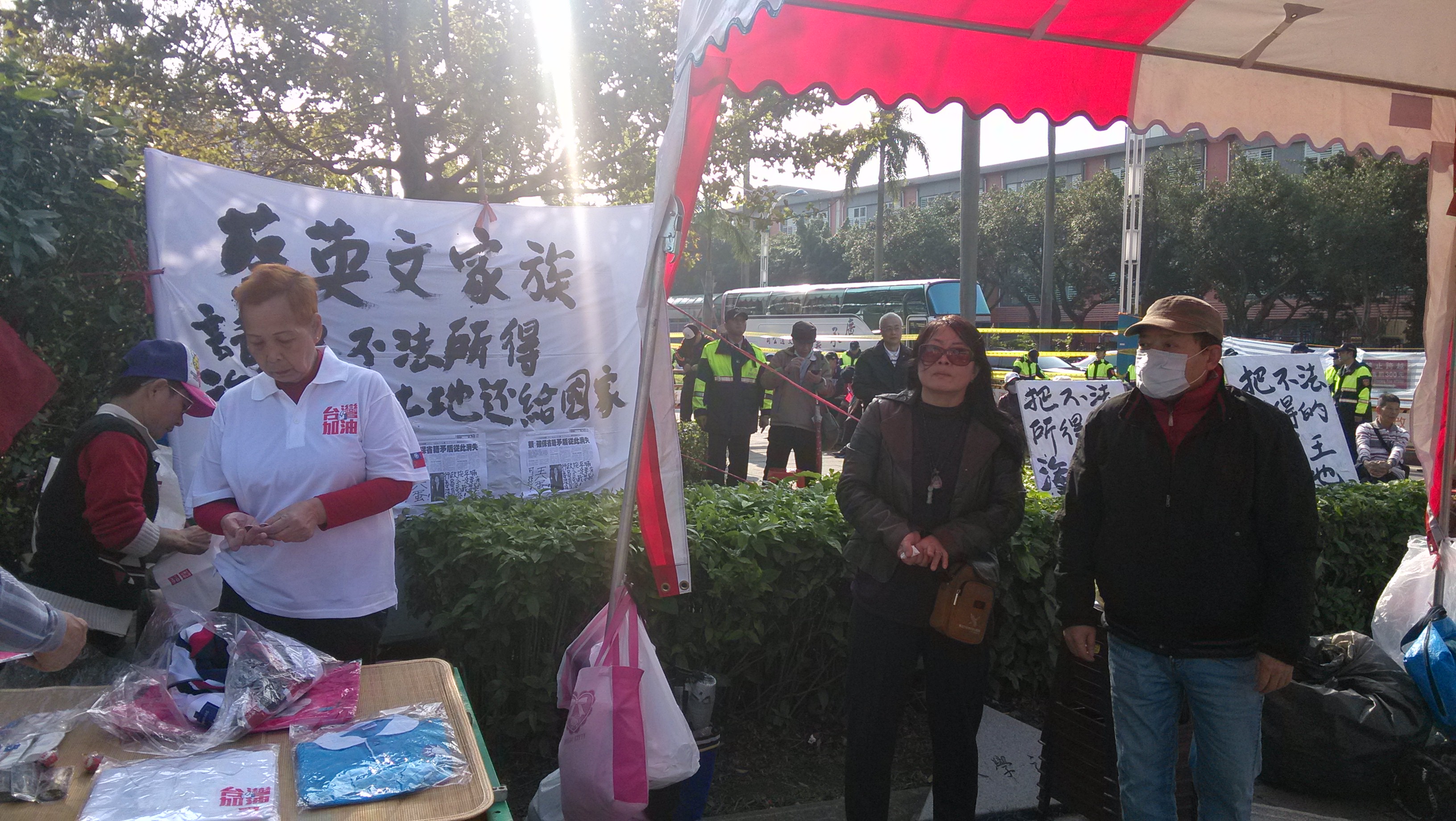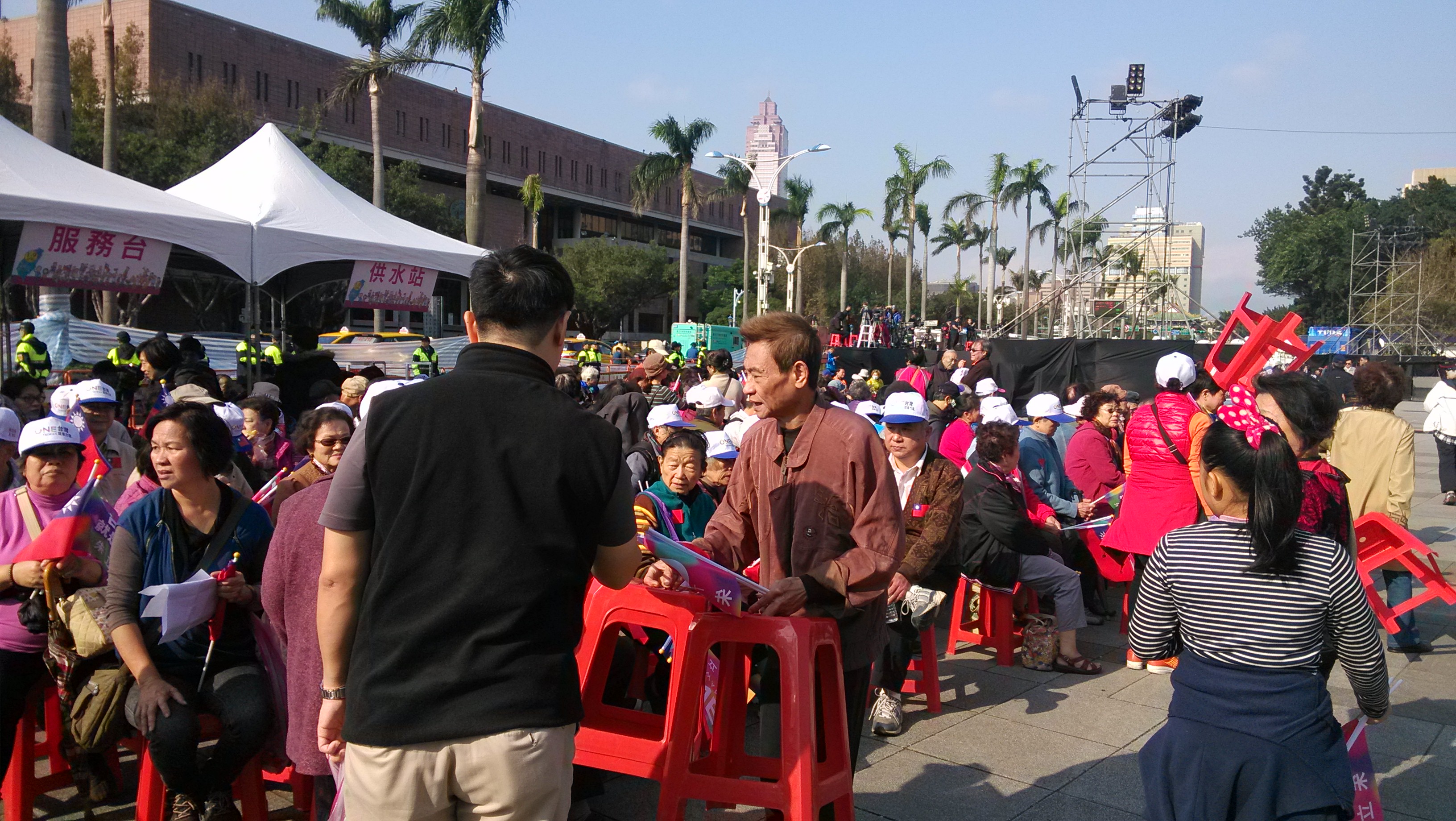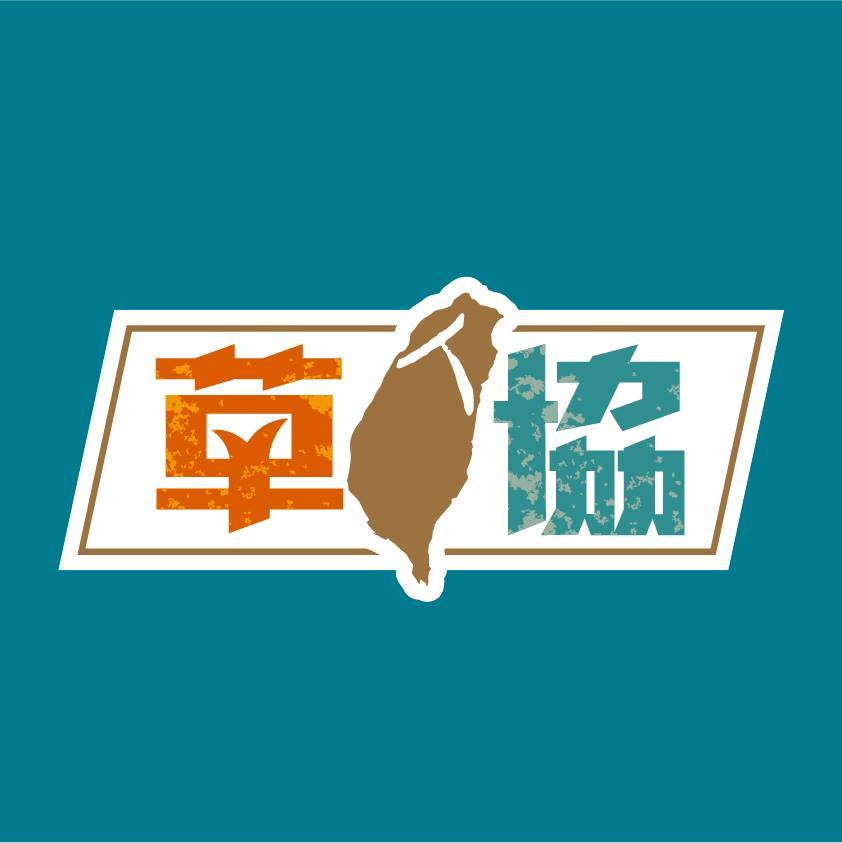by Brian Hioe
語言:
English
Photo Credit: UDN
Party Assets as an Legacy of Past Authoritarianism?
WHAT TO DO with the KMT’s party assets? This has been a question which has persisted from the first DPP administration under Chen Shui-Bian up until the present. And that no satisfactory method of resolving the question of what do about KMT party assets reflects that there is still no satisfactory answer of how to resolve questions of lingering authoritarianism by the KMT.
It is common within public discourse in Taiwan to claim that the KMT is the world’s richest political party. However, the actual statistics comparing the KMT to every other political party in the world and empirically proving it to be the world’s richest political party are scarce. Such a claim would be hard to establish, except through negative evidence.
 Infographic of KMT party assets as compared to party assets of other political parties in Taiwan. Photo credit: kmt.exposed
Infographic of KMT party assets as compared to party assets of other political parties in Taiwan. Photo credit: kmt.exposed
Nonetheless, it is well known that the KMT has possessed substantial resources. It is a myth that the KMT’s current party assets consist of the gold it brought over from China in 1949, as feeding into notions of the KMT as a bandit party which loots from wherever it resides, whether when in China or when it came to Taiwan. Yet there is no denying the existence of substantial party assets by the KMT, which are holdings in everything from news agencies, construction companies, hospitals, and karaoke to 870 pieces of real estate scattered across Taiwan from Taipei to Kaohsiung, though seemingly concentrated in Taipei. Total assets in 2014 totaled 26.8 billion NTD ($892.4 million USD), which generated 981.52 million NTD in interest that year. Though not exactly stolen gold from China, KMT party assets may be a legacy of past authoritarianism nonetheless, assets often alleged to be the result of past state-owned monopolies and land seizures by the KMT during the authoritarian period.
However, the KMT’s assets may have actually shrunk in recent history. The KMT’s party assets were estimated to be between 200 and 500 billion NTD in the early 2000s and there being even larger claims by Wealth Magazine (財訊月刊) in 2000 that KMT assets could be as high as 600 billion. There have been accusations against Ma recently, coming from within the KMT, that he embezzled the missing 170 billion which disappeared if KMT assets are now only 27 billion in KMT assets. Accusations of Ma embezzling have been longstanding and may reflect internal party conflict more than actual corruption on the part of Ma. Though laws require political parties in Taiwan to report their party assets, fluctuating numbers of what the KMT’s total party assets are could also be a product of that some assets are hidden in a network of dummy corporations and organizations. For its part, the KMT claims to have had 62.8 billion NTD in 2000, which declined to 23 billion NTD in 2006, as a result of losses.
 KMT rally on January 9, 2014 at Freedom Plaza. Sign in the background reads, “Tsai Ing-Wen’s family should reveal their illegal activities”. The KMT continues accusing DPP opponents of corruption, accusations against real estate speculation by Tsai Ing-Wen’s family after incidents of real estate speculation by KMT vice presidential candidate Jennifer Wang came to light. Photo credit: Brian Hioe
KMT rally on January 9, 2014 at Freedom Plaza. Sign in the background reads, “Tsai Ing-Wen’s family should reveal their illegal activities”. The KMT continues accusing DPP opponents of corruption, accusations against real estate speculation by Tsai Ing-Wen’s family after incidents of real estate speculation by KMT vice presidential candidate Jennifer Wang came to light. Photo credit: Brian Hioe
With so much financial resources, one wonders how exactly the KMT is capable of being politically defeated at all. The DPP or any other political party has never compared to the KMT in terms of financial resources, reporting less than one-third of the reported income of the KMT in 2015. We see this in that the KMT was the only party in past elections to spend money campaigning at a deficit, given its massive reserve of funds to draw on. The first DPP administration under Chen Shui-Bian demanded the return of party assets, which Chen alleged had been taken from the government and in that way stolen from the people of Taiwan. But Chen was unable to settle the party asset issue and the KMT would leap onto Chen’s embezzlement scandal as a means to to accuse Chen of being hypocritical in calling the KMT corrupt when he himself was corrupt, in that way obfuscating the issue.
Either way, Chen was unable to settle the issue. Public tarnish on the KMT was sufficient that Ma Ying-Jeou pledged to settle the party asset issue once and for all. Ma made this pledge during his run for his first term in office as well as during his run for his second term, but did not carry this out. After Ma resigned as KMT party chairman following the defeat of the KMT in nine-in-one elections, Chu made the same promise as chairman of the KMT and its eventual presidential candidate in 2016 elections. Before either Ma or Chu, Lien Chan had also made the same promise during his presidential run against Chen Shui-Bian in 2004.
Under increased scrutiny, KMT has of late been selling off assets and contributing the proceeds to government, pretending that they never existed. But, in addition to claiming party assets are run by trusts it is not involved in, selling off property and party-owned businesses and donating proceeds has been a preferred strategy of the KMT to allay criticism about party assets. In cases of donations, it is a question as to whether the donations are always of the full value of sold assets, however.
Challenges of Transitional Justice
IN TRUTH, the inability to settle the KMT party asset issue reflects the challenges of transitional justice in Taiwan. The KMT operates as a political party in Taiwan still despite its legacy of authoritarian rule and its past crimes committed during the authoritarian period.
Indeed, individuals associated with the KMT complicit in the past history of authoritarianism go free in Taiwan, including James Soong of the People First Party, who recently just ran for president and lost, the fourth time Soong has launched a bid for the presidency. Soong was a figure responsible for past crackdown on dissidents during the authoritarian period, as Director-General of the Government Information Office. None other than current president Ma Ying-Jeou reportedly opposed democratic reforms in the 1990s, opposing direct elections for presidency, and opposing the repeal of the anti-sedition laws which the KMT used to silence dissent.
 KMT rally on January 9th. Photo credit: Brian Hioe
KMT rally on January 9th. Photo credit: Brian Hioe
And the KMT has not fully been divorced from authoritarian rule when it still has its grip on aspects and sectors of the state, as we see in actions of the Ministry of Foreign Affairs or even the Ministry of Education. Such control may not be direct party control, as it would have been in the past, but amounts to that the personalist interest networks of the KMT still exist within the Taiwanese state and allows the party to leverage undue influence over policy.
Yet post-democratization, the KMT is still treated as a political party like any other, in spite of how the KMT is not just one party among many other equal parties. In some sense, the KMT actually uses the claim that it is democratic and that Taiwan is now a full democracy to avoid persecution for its continued authoritarianism. By claiming that it is one democratic party among many others seeing provides a useful means for the KMT to shield itself from those who would target the party itself. And this serves to mask its undemocratic grip over elements of government.
The party assets issue is a case in point, where up until now, it seemed impossible to force the KMT to return party assets if it did not consent to doing so itself or for legislature to pass measures to resolve the KMT party assets issue—this because the KMT controlled the legislature, if it had lost the presidency during the Chen Shui-Bian era. We will see as to whether things are different now with a Tsai presidency and a DPP-dominated legislature.
Yet this raises continued questions of how exactly to settle not only the question of party assets but transitional justice for the KMT itself. In a moment in which the KMT looks like it might collapse in the future, it may be that the KMT’s party assets are something that can hold the party together. Party assets are something which KMT politicians that might otherwise bolt the party otherwise do not want to lose their stake in the KMT’s party assets. It is popularly believed by many that high-ranking members of the KMT have used the party assets to line their own pockets. If the party were to collapse in some form, would the spoils be divided among who is left in the KMT?
Newly elected DPP candidate Tsai Ing-Wen has vowed to address and some voices in the KMT call for resolving the party assets issue as a matter of the Taiwan’s people’s trust. The “Sandals Union” (草協聯盟) formed out of the KMT Youth Section, has actually called for internal reform of the KMT which includes dealing with the party asset issue in order to win back the trust of the people and as a matter of worker’s rights. Other reforms include calling for increasing transparency and youth participation on the part of the party.
We shall see as to how the demands of the “Sandals Union” fare, although the immediate response seems to have already been attacks on them by other KMT for having been “brainwashed by the DPP” or having covert green sympathies. If young members of the KMT raised on KMT ideology from youth have, in fact, been attempting in the past year to establish common ground with their Sunflower generation peers, now we see quite clearly how the KMT treats internally its younger voices that call for party reform.
 “Sandals Union” logo. Photo credit: 草協聯盟
“Sandals Union” logo. Photo credit: 草協聯盟
But party assets are only one piece of the puzzle where the question of how to take care of the KMT is concerned. It would be hard for Tsai to address the party asset issue when the KMT is largely treated in the present as if it were a “normal” democratic party, as one party among equals. This the KMT is not, as we see in the existence of party assets to begin with. Furthermore, this leaves unresolved the question of transitional justice. Tsai Ing-Wen might be able to take action on the party assets issue, but taking action against the KMT would still be perceived as undemocratic, as the DPP taking revenge against the KMT in some light.
In this way, Taiwan faces the challenge of the overlap of its semi-democratized present and the lingering traces of authoritarian rule. Again, it is that the view of Taiwan as a democracy can actually allow for the preservation of the lingering traces of authoritarianism. Such are the contradictions of a semi-democratized nation-state.


 Infographic of KMT party assets as compared to party assets of other political parties in Taiwan. Photo credit: kmt.exposed
Infographic of KMT party assets as compared to party assets of other political parties in Taiwan. Photo credit: kmt.exposed KMT rally on January 9, 2014 at Freedom Plaza. Sign in the background reads, “Tsai Ing-Wen’s family should reveal their illegal activities”. The KMT continues accusing DPP opponents of corruption, accusations against real estate speculation by Tsai Ing-Wen’s family after incidents of real estate speculation by KMT vice presidential candidate Jennifer Wang came to light. Photo credit: Brian Hioe
KMT rally on January 9, 2014 at Freedom Plaza. Sign in the background reads, “Tsai Ing-Wen’s family should reveal their illegal activities”. The KMT continues accusing DPP opponents of corruption, accusations against real estate speculation by Tsai Ing-Wen’s family after incidents of real estate speculation by KMT vice presidential candidate Jennifer Wang came to light. Photo credit: Brian Hioe KMT rally on January 9th. Photo credit: Brian Hioe
KMT rally on January 9th. Photo credit: Brian Hioe “Sandals Union” logo. Photo credit: 草協聯盟
“Sandals Union” logo. Photo credit: 草協聯盟